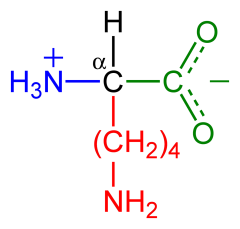I imagine that the word “reactive” caused most readers to think of this:
However, what we will actually be talking about is this:
Yeah, not quite so dramatic, I admit. However, the reality is that the amount of reactive lysine present in your dog’s food is much more likely to have an impact on his health and wellness than is the somewhat lower risk of meeting Mr. Crabby Pants pictured above.
The reason? Well, its all about the protein quality of commercial dog foods – the good, the bad, and the reactive.
Reactive lysine: Lysine is one of the 10 essential amino acids (the building blocks of proteins) that must be provided in a dog’s diet. The term essential means that dogs cannot produce these amino acids endogenously (in the body) and so they must be supplied by the protein in the food. Of the essential amino acids, lysine is rather unique in that it has a reactive amino group (the blue H3N+ in the graphic above). This group hangs out into space waving its H+ around, which is ready and able to engage and link up with other molecules. And, just as with reactive dogs, these encounters do not always end well.
When food proteins are subjected to heat treatment and other processing conditions, some of this lysine binds to certain sugars and amino acids. When this occurs, the modified form of lysine is not available, meaning that the dog is unable to use the lysine, even after it has been digested and absorbed into the body. Some of the altered lysine may be modified further to produce compounds called “advanced Maillard compounds“. Maillard products are actually quite well-known to most people – they cause the browning of the toast that you eat for breakfast, on the onions that you caramelize, and form the grill lines on your hamburger.
Reactive lysine in dog foods: Tasty toast aside, for dogs and commercial dog foods, measures of the amount of reactive lysine and Maillard compounds provide an indication of a food’s protein quality. This goes above and beyond digestibility (which we discussed in an earlier blog, “Scoopin’ for Science“), because the amount of reactive lysine reflects the actual nutritive value of the protein once it has been digested and absorbed into the body.
Processing damages protein: The heat treatment that is used to produce commercial dog foods has many benefits – it functions to improve a food’s overall digestibility, enhances shelf life, and assures food safety. However, heat and mechanical processing can also result in damage to the food’s protein. The good news is that the degree of this damage can be measured using laboratory procedures that analyze reactive (available) lysine (RL) and total lysine (TL). A ratio is then calculated between these two values (RL:TL). A high ratio value reflects more reactive lysine, less protein damage and higher quality protein. Conversely, a low value signifies greater loss of lysine during processing, more damage to the protein, and lower quality.
Cool, right? Well, yeah. Really cool. Because measuring reactive lysine ratios provides us (dog folks) with an indication of how processing such as canning, extrusion, rendering, and even dehydration or freeze-drying, might damage food protein and reduce the overall quality and nutritional value of a dog food.
Too bad this information is never reported by pet food companies. (To date, they are not required to report any measures of food digestibility or protein quality to their consumers).
Even though pet food manufacturers are not reporting these values, a group of scientists have been.
The Study: Researchers with the Animal Nutrition Group at Wageningen University in The Netherlands have been examining reactive lysine content and Maillard reaction products in a variety of commercial pet foods. In a recent paper, they collected 67 different brands of dog and cat foods, formulated for different life stages (1). Lysine levels were measured for each, and RL:TL ratios were calculated. The researchers also compared available lysine levels in the foods to the minimum lysine requirements reported by the current NRC Nutrient Requirements for Dog and Cats.
Results: A wide range of RL:TL ratios were reported, suggesting that protein damage in commercial foods is highly variable and may not be dependent simply on the type of processing that is used:
- Processing type vs. ingredients: Overall, as reflected by the RL:TL ratio, canned foods had less protein damage than extruded foods, which had less damage (surprisingly) than pelleted foods. However, the range of values within processing type was very high with the three types of foods showing a lot of overlap. This suggested that source and type of ingredients may matter as much as or even more than processing type.
- Ingredients: Many of the ingredients that are used to produce pelleted and extruded foods are pre-treated with heat, drying and grinding. For extruded foods, this refers primarily to the production of meat meals (see “What’s the Deal with Meals” for a complete discussion of protein meals). It is speculated that this processing and how well it is (or is not) controlled is the most important determinant of changes in protein quality.
- Meeting lysine requirements: Of the foods that were examined in this study, up to 23 percent of a product’s lysine could be damaged and made unavailable to the dog. When these losses were considered while accounting for expected protein/lysine digestibility, some of the foods were expected to be at risk to not meet the minimum lysine requirement for growing dogs.
The authors conclude: “Ingredients and pet foods should be characterized with respect to their reactive lysine content and digestibility, to avoid limitations in the lysine supply to growing dogs” I would add to this that these measures should be available in some form to consumers, as a measure of the protein quality of the food that they are considering buying.
Detractors might argue that RL:TL ratio is “too complex” for consumers to process and understand. I disagree. A simple classification chart, such as “poor, moderate, and high” quality could be derived from the range of reactive lysine values that are reported. Knowing this information, along with the type and source of ingredients, would allow owners to make meaningful quality distinctions among foods.
I have argued elsewhere that pet food producers should be required to provide digestibility information about their products, when requested. This is not too much to ask, seeing that manufacturer’s claims of “Complete and Balanced” promotes the feeding of their products as the sole source of nutrition to our dogs. And now, according to the results of research coming from Wageningen University, there are additional measures of protein quality that can differentiate among poor, adequate and superior foods.
It is time to ask for more of pet food manufacturers. Measuring digestibility and reactive lysine levels of foods and ingredients provide measures of product quality that are directly pertinent to nutritive value and to our dogs’ health. Here is your chance, as your dog’s advocate, to be a bit reactive (no – PROACTIVE) with your pet food manufacturer…… Politely request this information about the products that you are buying – let me know what you hear back!
 Cited Study: van Rooijen C, Bosch G, van der Poel AFB, Wierenga PA, Alexander L, Hendriks WH. Reactive lysine content in commercially available pet foods. Journal of Nutritional Science 2104; 3:e35:1-6.
Cited Study: van Rooijen C, Bosch G, van der Poel AFB, Wierenga PA, Alexander L, Hendriks WH. Reactive lysine content in commercially available pet foods. Journal of Nutritional Science 2104; 3:e35:1-6.





Interesting.
Are there any clear symptoms of lysine deficiency in dogs ?
LikeLike
Hi Peter, Lysine requirements (and signs of deficiency) for dogs were determined using experimental studies in the 1970’s and 1980’s. Signs of lysine deficiency are similar to that of other EAAs – failure to thrive, reduced appetite, decreased growth rate, weight loss. A dietary lysine deficiency should be very rare in dogs, even given the concerns of the researchers. What is probably of more importance to feeding dogs today is the use of a reactive lysine test as a measure of the degree of protein damage/modification that occurs with processing and how this can affect overall product and protein quality. In addition, the production of the Maillard products that come from excessive processing may be associated with health risks to dogs (there is some evidence of this with humans). The same research group that conducted the study above are currently looking at this issue as well. Thanks for reading and posting – Linda
LikeLike
Good question. And can it be supplemented?
LikeLike
Hi Bitsey, Supplementing an essential amino acid to a dog’s diet should never be needed, if a dog is being fed a high quality food. The more important issue is finding a food that has highly available and properly processed protein, not trying to supplement a poor quality and poorly processed food. Linda Case
LikeLike
Pingback: #DogFood the amount of reactive lysine is much...
Wow, why aren’t the manufacturer’s of human food not doing this??? They don’t do digestibility studies let alone anything else.
LikeLike
Sorry, meant to say why don’t the human food manufacturers do this?
LikeLike
BJ – The difference is that no single human food is formulated or expected to provide complete and balanced nutrition to the human that consumes it. The issue with pet foods is that food manufacturers promote them as complete and balanced and state that their food and only their food should provide everything that a dog or cat needs for health. This is a very high standard and so should be validated. It is not necessary with human foods as no one makes that claim for a human food.
LikeLike
Great article, thank you. I was wondering if you know of any commercial labs in Canada or the U.S. that test for reactive lysine.
LikeLike
Hi Jennifer – I do not, as I do not do this type of work. However, a Google search for commercial, analytical laboratories should provide this pretty readily. Linda
LikeLike
I inquired about the Wellness Reduced Fat Core food that I feed. The reply is worthless as far as I can see:
Here are the nutritional values you have requested:
AAFCO Dog Food Nutrient Profile Based on Dry Matter
Growth & Reproduction Min: 0.90%
Adult Maintenance Min: 0.63%
WDD CORE RF
2.04% Dry Matter (well above the minimum requirement)
LikeLike
Hi BItsey – They sent you measured lysine, which will not tell you how available that lysine is. It would be interesting to ask them if they measure reactive lysine….. Thanks for doing this and for posting the response that you received! Linda
LikeLike
I wrote them back and told them they hadn’t really answered my question. Stay tuned!
LikeLiked by 1 person
Here is what I heard from Canidae about their Blue Sky Duck Grain Free:
Elizabeth,
Thank you for contacting Canidae pet foods. We do not do any tests to determine the breakdown of the Lysine in our diets.
Sincerely,
J Tarlow, DVM
LikeLike
Oh well. At least they are forthright and honest with you. That definitely counts for a lot these days. Thanks for your persistence with this, Bitsey! Linda
LikeLike
Great piece, but I think I missed what the impact is to a dog who does not get lysine in their diet. I would love to learn more and share. You explained the process clearly and how it can be missing (or not) in dog food, but I think “the why” it’s important would help to make people want to advocate. Thank you for always educating us!
LikeLike
Hi Mel – Thanks for your note. I think I answered this in my reply to Pete and Bitsey above. Of more concern is how reactive lysine tests reflect processing damage to protein, production of Maillard products, and overall food quality. I hope to post more on this topic soon! Thanks for reading and for your comment. Linda
LikeLike
Pingback: Mind Your Peas and Potatoes – The Science Dog
Pingback: The Raw Deal – The Science Dog
Pingback: Its Maillard, not Mallard – The Science Dog
Pingback: HPP and Raw Foods – The Science Dog
Pingback: It’s Here, It’s Here! | The Science Dog
Pingback: Raw Evidence | The Science Dog